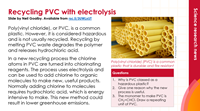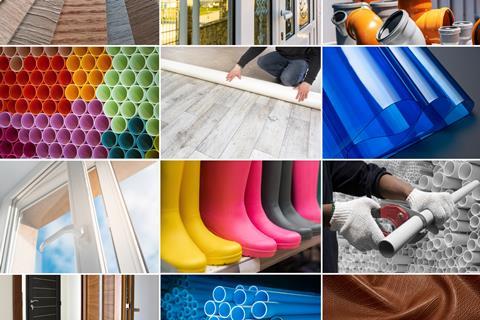Chemists use electrolysis to produce industrially-useful products from waste poly(vinylchloride)
-

Download this
Use this story and the accompanying summary slide to add new context when teaching about PVC and plastics to your 14–16 learners.
Download the story as MS Word or PDF and the summary slide as MS PowerPoint or PDF
Researchers in the US have figured out how to safely recycle poly(vinylchloride) (PVC) into industrially-useful chemicals.
Anne McNeil and her University of Michigan team have developed an electrolysis method to recover chlorine from waste PVC and attach it to aromatic compounds. The resulting chlorinated aromatic compounds are widely used in medicine and agriculture.
PVC is one of the most commonly used thermoplastic polymers in the world. It’s used for items such as plumbing pipes, window frames, cable and wiring insulators, floorings, roofing membranes, flexible tubing, blood bags, car interiors, shower curtains, wellingtons and raincoats. However, despite its extensive use, PVC is rarely recycled. Plastics tend to be mechanically recycled, meaning they are melted and then reformed into lower quality materials. A water bottle, for example, might become a textile or a park bench. Heating PVC isn’t safe as it releases corrosive chlorine compounds and highly toxic phthalates (plasticisers that disrupt the endocrine system), so PVC needs to be separated from any plastics that are destined to be mechanically recycled.
Extracting valuable chlorine
The research team set their sights on developing a chemical recycling method for PVC. Using electrolysis, they figured out how to safely recycle PVC into industrially-useful chemicals. Their process has two stages that take place in a single electrochemical cell. In the first stage, at the cathode, chloride anions are stripped off the polymer backbone. This removal process is facilitated by one of the plasticisers present in PVC: di(2-ethylhexyl) phthalate (DEHP). The second stage, which takes place at the anode, involves inserting chlorine into aromatic compounds.

Using this method, the team effectively halogenated a broad range of aromatic compounds. Industrially, around 85% of pharmaceutical syntheses involve chlorine chemistry, most requiring hydrochloric acid, which is energy intensive to make. A preliminary life cycle assessment reported a 71% reduction in greenhouse gas emissions using Anne’s chlorination method, compared with this industrial standard.
‘This is a unique example of repurposing plastic waste,’ comments Timothy Noël, a chemical engineer at the University of Amsterdam not involved in this research. ‘That the chlorine atom of PVC can be used to electrochemically chlorinate new molecules is particularly impressive.’
The chemists demonstrated that the method works in the presence of other plastics, so PVC does not need to be separated from mixed plastic waste before recycling. Current focuses for the team include fine-tuning the recycling process and finding a use for the leftover dechlorinated polymer.
Put this in context
Find out more about applying chemistry to real-life problems by exploring how Margot, a research innovations manager, develops ways to make plastic breakdown quickly in the natural environment.
Nina Notman
Reference
DE Fagnani et al, Nat. Chem., 2022, DOI: 10.1038/s41557-022-01078-w
This article is is adapted from Victoria Atkinson’s in Chemistry World.
Downloads
EiC science research story Recycling PVC
Handout | PDF, Size 0.24 mbEiC science research story Recycling PVC
Handout | Word, Size 0.62 mbEiC summary slide Recycling PVC
Presentation | PDF, Size 0.24 mbEiC summary slide Recycling PVC
Presentation | PowerPoint, Size 1.24 mb














No comments yet